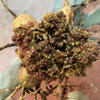I found this informative article about the Saran Wrap Storage Method on The Michigan Dahlia Societies Website.
Dahlia Boy.
No Fuss: Store Your Tubers in Plastic Wrap
By Marian Mandella, Bernard Mandella, and Richard W. Peters, M.D.
Nothing is more sacred to an experienced dahlia grower than his/her method of storing tubers over the winter. This article is not for them, as they have found their favorite way already. However, if their curiosity or experimental impulses are strong enough, they may want to try a dozen or so tubers stored by this new method.
In any storage method, the ultimate goal is to preserve the tubers as closely as possible to the condition they were in when they were dug in the fall. Our method is devoid of any storage mediumno peat moss, vermiculite, sand, wood shavings or cedar chips. We use Saranwrap or other plastic wrap found in your local supermarket. The advantages we have seen are: no bother with a bedding medium, no worry about contamination of vermiculite with asbestos, much less storage space needed for your tubers and ease in locating your tubers in storage. In addition, this new method has a distinct advantage in that you do not have to check the tubers during the winter storage as is recommended for the vermiculite/plastic bag method.
Initially we had valid concerns about this new method, so the first year we packed 25% of our yearly supply of tubers (1,200 to 1,500) in plastic wrap and 75% in vermiculite/plastic bags, and the results with the plastic wrap were outstanding. Each successive year we stored 25% more in plastic wrap, so that now for the past two years, 100% of our tubers have been stored by the new method.
Digging, washing and dividing are thoroughly covered in earlier Bulletins as well by a comprehensive article by Alan Fisher on the ADS Website (www.dahlia.org "Selected Articles of Interest). Therefore we will begin the description of our method starting with the freshly divided tuber. We recommend the use of a fungicide to reduce the numbers of fungal spores present on the tubers. We experimented initially with two fungicides: Daconil for liquid immersion and powdered garden sulfur for dusting. Daconil and other liquid fungicides are fairly expensive and hard to find, whereas powdered sulfur is reasonable and readily available.
Should you decide to dust with sulfur, which is the method we currently use, just add 8 quarts of vermiculite to one cup of powdered sulfur in a tall kitchen plastic trash bag and mix thoroughly. After the divided tubers have been washed and labeled, put a few in the mixture (they may be dry to slightly damp) and gently roll them aroundÂvery much like "Shake and Bake". This will apply a uniform coating over the entire surface. More sulfur can be added as deemed necessary. We have a lot of latitude here: the ratio of sulfur to vermiculite, the size of the plastic bag, or the manner in which the sulfur is applied is discretionary. Also, extenders such as very dry peat moss or fine white play sand can be substituted for the vermiculite.
After the tubers are divided, washed, labeled and treated with a fungicide method, set them aside to dry overnight. We advise wrapping them as soon as they are sufficiently dry, since tubers tend to get spongy and subject to drying out if permitted to sit around in the open for long periods of time. With this method you will also note that those tubers with slender necks can be preserved.
Tear off a sheet of plastic wrap about 20 or more inches long and lay it flat on a level surface. Place a tuber on one end and roll the plastic wrap over one complete turn. Lay another along side and roll again. Be certain that no tuber is touching another; plastic wrap must separate all tubers. You may wrap up to five tubers or so per package, but in the last 5-7 inches, fold over the side portions of the plastic wrap and continue to roll to completion. Fasten with a piece of masking tape that is labeled with the cultivarÂs name and any other information.
The wrapped tuber bundles should be stored at 40-45 degrees F in corrugated boxes or other containers that you would ordinarily use. The tubers emerge very firm, and the losses to tuber rot have been in the order of 3-6% per year. There is essentially no loss from shriveling or drying.
When you are ready to plant or pot your tubers, simply open the package, remove the tubers and check for eyes. The tubers tend to eye up earlier with this method, but some will be blind stock with no eyes. Some cultivars, like Walter Hardisty, are notoriously slow to eye up. These can be placed in shallow nursery flats, covered with damp peat moss and placed in 70-75 degrees F. In a week or so the tubers can be rechecked for eye development.
A pertinent question arose as to whether the close packing would encourage and spread tuber rot, very much like the "rotten apple in the barrel". We have found that the rot fungus is slightly more transferable in the vermiculite/plastic bag method. During our experimental years we put half of the tubers from the same clumps in vermiculite and half in plastic wrap. Interestingly enough, those that rotted did so by both methods, which leads us to believe that the clumps were infected prior to storage and were unlikely to have survived in any storage method. There were also occasions in plastic wrapped bundles when one or two tubers would rot but the others would not. We believe that the thin layer of plastic is protective when the package is wrapped so that no two tubers ever touch.
Another question was whether the close packing would cause the tubers to "sweat". Condensation is a function of temperature and humidity and occurs when warmer humid air comes in contact with cold air. Tubers are generally stored in garages at fairly uniform temperatures ranging between 40 and 50 degrees F. The garage temperature and the storage box temperature are quickly equalized. Therefore, without a great temperature differential, it is unlikely that any appreciable condensation would occur.
Other questions and comments will surely arise as more growers share their experiences, but for getting started with our method just remember: dig, wash, divide, label, treat with fungicide, wrap in plastic wrap, pack in boxes and store at 40-45 degrees F. Dahlia growers are very inventive and resourceful and will most certainly be able to expand, improve and adjust this method to suit their own personal preferences.













Poochella
dahliaboyOriginal Author
Related Professionals
Harvey Landscape Architects & Landscape Designers · Salem Landscape Contractors · Apollo Beach Landscape Contractors · Corona Landscape Contractors · Farmington Landscape Contractors · Harrisburg Landscape Contractors · Pleasant Prairie Landscape Contractors · Rockville Landscape Contractors · South Lyon Landscape Contractors · Spring Landscape Contractors · 07920 Landscape Contractors · Cicero Fence Contractors · Ponte Vedra Beach Fence Contractors · Compton Solar Energy Systems · Rosemount Solar Energy Systemshemnancy
Poochella
emjaysee